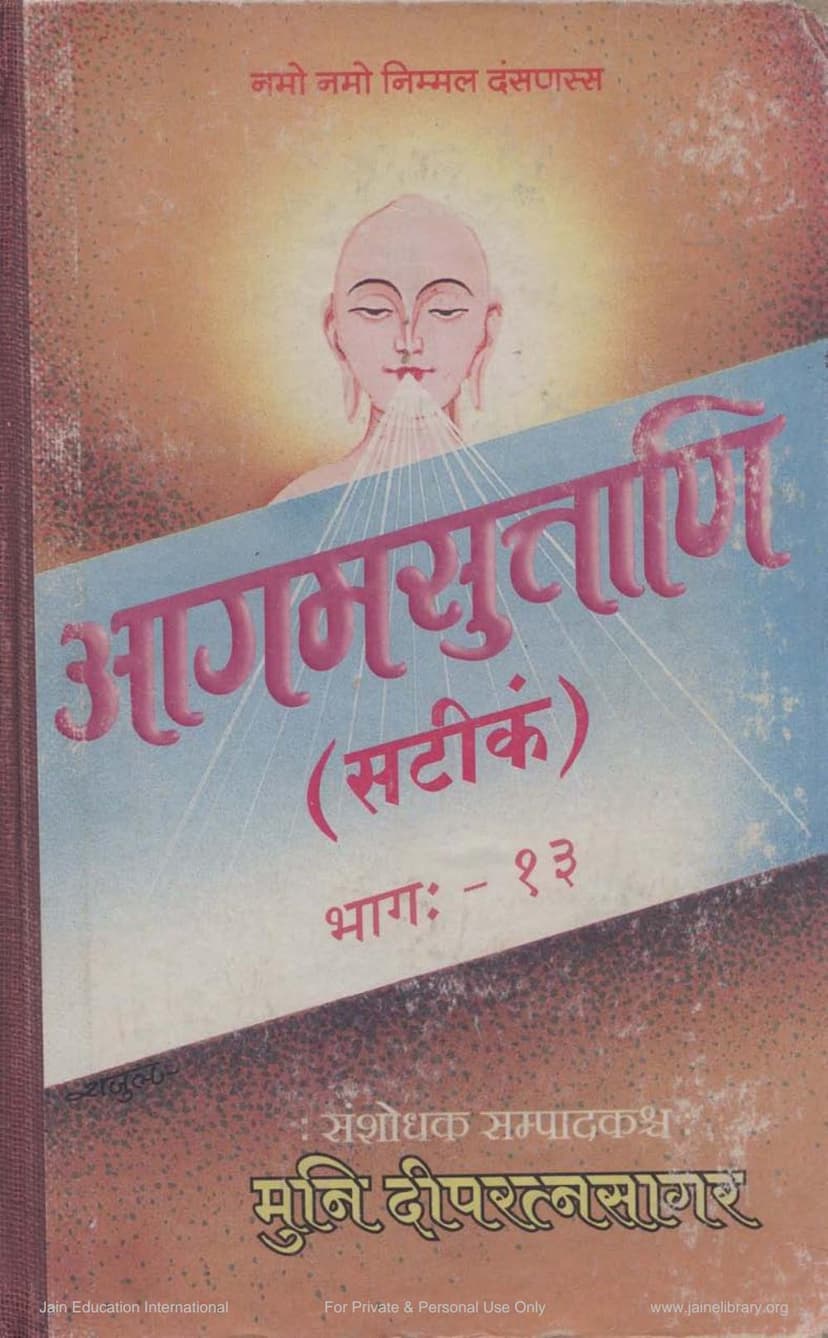Agam Sutra Satik 18 Jamboodwippragnapati UpangSutra 07
Added to library: September 1, 2025

Summary
Here's a comprehensive summary in English of the provided Jain text, "Agam Sutra Satik 18 Jamboodwippragnapati Upangsutra 07," based on the provided pages:
Book Title: Agam Sutra Satik 18 Jamboodwippragnapati UpangSutra 07 Author(s): Dipratnasagar, Deepratnasagar Publisher: Agam Shrut Prakashan
Overall Context:
This text is the seventh Upang Sutra, titled "Jamboodwippragnapati," which details the Jambu Island within the Jain cosmology. The provided pages are from a commentary (Satik) of this Sutra, compiled and researched by Muni Dippratnasagar. The commentary aims to elucidate the profound and complex meanings of the original Jain scriptures for the benefit of spiritual seekers.
Key Themes and Content Summary:
The initial pages (1-7) are introductory, including:
- Invocation: Salutations to the pure vision (Nirmal Darshan) and to the spiritual gurus.
- Title and Authorship: Clearly stating the book title, volume number (Part 13), and the name of the researcher/editor, Muni Dippratnasagar.
- Publisher and Contact Information: Details about Agam Shrut Prakashan and their contact address.
- Table of Contents (Vishayanukram): A detailed breakdown of the seven Vyakara (sections) of the Jamboodwippragnapati Upang Sutra, outlining the topics covered in each section. These include:
- Vyakara 1: Measurements, structure, appearance, world system, gateways, pedestal, forests, gates, capitals, Bharat Kṣetra's location, measurements, divisions, southern half of Bharat, Vaitāḍhya mountain, Siddhayatana description, northern half of Bharat.
- Vyakara 2: Time (Avasarpini, Utsarpini), measure of time (Palyopama, Sagropama), Kalpavriksha description, sixfold division of time, description of inhabitants of each time period, Kulakara concept, Rishabhdeva's description, Nandiśvara Dvipa's Ashtāṇikā festival, Pacha Bhed Mangal Varsha.
- Vyakara 3: Reason for the name 'Bharat', Vineeta city, Bharat Chakravarti's narrative, origin of the Chakra jewel, journey of the six continents, Magadh, Prabhas, Vardaan Tirth description, fourteen jewels (their origin and function), Bharat Chakravarti's treasures, deities, armies, villages, etc.
- Vyakara 4: Description of the Chuḷḷa Himavant mountain (river-bearing mountain), Padma Lake, Padma concept, description of rivers like Ganga and Sindhu, Siddhayatana-like structures.
- Vyakara 5: Planets, Sun, Moon, constellations, and stars in Jambu Dvipa; Sun's circle, its dimensions, circumference, distance, etc.; Moon's circle, its dimensions, etc.; Nakshatra circles; classification of years; description of Tirthankaras and other supreme beings.
- Vyakara 6: Substances located in Jambu Dvipa; continents and mountains within Jambu Dvipa; rivers, caves, lakes, temples, etc.
- Vyakara 7: Description of the birth rituals of Jinavaras, arrival of Indras, Pandaka forest, Abhishēka Śilā, Śuśoṣa Ghanta.
- Sponsorship Information: Details about individuals and organizations who financially supported the publication of this work.
Detailed Content of the Commentary (Vyakara-wise):
The commentary, as outlined in the table of contents and the introductory pages, delves into the intricate details of the Jambu Dvipa, the first of the five Jambu Dvipas in the Jain universe. The structure of the Jambu Dvipa, its geography, the celestial bodies within it, the eras of time, and the lives of important figures like Bharat Chakravarti and Rishabhdeva are meticulously described.
- Cosmological Framework: The text establishes the Jain cosmological view, placing Jambu Dvipa at the center of the universe, surrounded by oceans and other continents.
- Jambu Dvipa's Geography: It details the dimensions, shape (circular, like a drum or oil cake), and the specific locations and measurements of various mountains (like Vaitāḍhya, Himavant, Mahāhimavant, Nila, Kanda), rivers (Ganga, Sindhu, Rohitāśva, Śītā, etc.), lakes (Padma, Jambu), and regions (Bharat Kṣetra, Mahāvideha, etc.). The text meticulously describes the layers and structures of Jambu Dvipa, including the circumferences of various celestial spheres.
- Time Cycles: The commentary explains the cyclical nature of time in Jainism, detailing the six stages of Avasarpini (descending cycle) and Utsarpini (ascending cycle), and the immense durations associated with these periods (Palyopama, Sagropama). It also touches upon the lifespan and characteristics of beings in different time periods.
- Celestial Bodies and Phenomena: The text describes the movements and characteristics of the Sun, Moon, and stars, and their role in delineating time.
- Jambū Dvipa's Inhabitants and Features: It speaks of various types of celestial beings (Devas) and their residences (Mahā-prāsādas, Māṇḍapas), the mythical Kalpa-vriksha trees and their miraculous properties, and the detailed descriptions of jewels, lotuses, and other celestial elements that adorn this realm.
- Sacred Sites and Rituals: It mentions sacred places like Siddhayatana and describes rituals like the birth celebrations of Jinavaras and the arrival of celestial beings for auspicious events.
- Historical and Mythological Figures: The text narrates the stories of prominent figures, particularly Bharat Chakravarti and Rishabhdeva, detailing their lives, achievements, and spiritual significance. The concept of Chakravarti (universal emperors) and their fourteen jewels is also discussed.
- Mathematical and Astronomical Precision: The text exhibits a remarkable level of mathematical and astronomical detail, providing precise measurements for various celestial and terrestrial features within the Jain universe, indicating a sophisticated understanding of these subjects within the ancient Jain tradition.
- Ethical and Spiritual Teachings: Underlying the cosmological and geographical descriptions are the Jain ethical principles, emphasizing pure vision, renunciation, non-violence, and the ultimate goal of liberation (Moksha). The commentary serves to reinforce these teachings by illustrating the grandeur of the spiritual realms and the virtuous lives of the liberated souls.
Methodology of the Commentary:
The commentary by Muni Dippratnasagar appears to be thorough, referencing original sutras, providing explanations for terms, and even discussing variations in ancient texts (Vachana Bheda). The inclusion of detailed descriptions of the Jambu Dvipa's features, the celestial phenomena, and the lives of important figures suggests a comprehensive approach to understanding the Upang Sutra.
Overall Purpose:
The purpose of this commentary is to make the ancient and profound teachings of the Jambu Dvipa Prajñapti accessible and understandable to a wider audience, fostering spiritual understanding and practice. It serves as a bridge between the original scriptures and the contemporary seeker, offering detailed explanations of the Jain cosmology and its associated philosophical and ethical underpinnings.